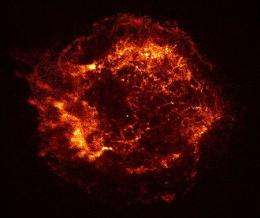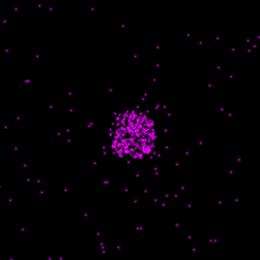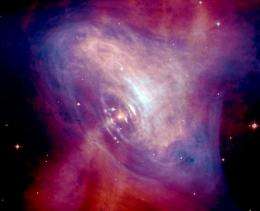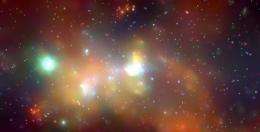Chandra X-Ray Observatory Turns Ten

"We and the cosmos are one. The cosmos is a vast body, of which we are still parts. …It is a vital power rippling exquisitely through us all the time." D.H. Lawrence*
About ten years ago Space Shuttle Columbia launched hauling 55,000 pounds worth of astronomers' dreams -- the Chandra X-Ray Observatory. This was the heaviest payload a space shuttle ever lifted - and one of the best day's labor the work-horse space shuttle ever put in.
August 19, 2009, marks Chandra's 10 year "first light" anniversary.** Last week some Chandra team members celebrated the observatory's past decade of dramatic discoveries. Project scientist Martin Weisskopf has devoted over 30 years of his life to the observatory. Addressing an audience of current and original project leaders, researchers, and others, he described the scene on Earth during Chandra's first weeks in orbit.
"After the launch, we waited for good things to happen," he began. From the back of the room at the National Space Science and Technology Center in Huntsville, Alabama, came this interruption: "We're getting old, Martin! Speak up!" Without missing a beat Weisskopf answered "I've got my hearing aid in," evoking a hearty laugh from the audience.
He and some of the other master telescope builders in that audience may be nearing retirement, but they're still vigorously pursuing new science with their equally robust observatory.
Weisskopf continued describing the suspense they felt ten years ago: "First we waited for Chandra's internal propulsion system to position the instrument in proper orbit. Then we waited for instrument checkout. Then we waited for a series of doors to open. Finally, we saw the first image and emitted a collective 'ahhhh.' Our telescope worked!"
Not only did it work, it triumphed. And it's still going. The observatory is ready to take its second generation of explorers on a wild ride through the cosmos.
To the naked eye, and even to some types of telescopes, the night sky looks serene. But the universe is really a place of sudden and chaotic violence, teeming with supernova explosions, million-degree clouds of intergalactic gas, and seething disks of torn-up matter swirling around black holes. Chandra is unique in its ability to see this crucial hot world that holds the key to so many scientific mysteries.

And it all started when the "Cas A" supernova remnant posed for Chandra's official first light image. Scientists deduced that material blasted into space from the explosion crashed into surrounding material at 10 million miles per hour. The collision caused violent shock waves, like massive sonic booms, spawning an enormous 50-million degree bubble of X-ray emitting gas.
Heavy elements in the hot gas produce X-rays of specific energies. Chandra can precisely measure these X-rays and reveal how much of each element is present. With this information, astronomers can probe how the elements necessary for life are created and spread throughout the galaxy by exploding stars.
In short, Chandra has helped confirm that we are star stuff.
"The iron in our blood came from some star that exploded perhaps billions of years ago," says Weisskopf.
After just two months in space, Chandra took a stunning image of another supernova explosion, the Crab Nebula, and showed for the first time the luminous rings of high-energy particles surrounding its core:

Combined with observations from the Hubble Space Telescope, Chandra data yielded clues about how rotation of the pulsing neutron star at the center of the Crab Nebula powers the nebula, which still glows brightly 1,000 years after the explosion.
Chandra has also been schooling astronomers about quasars, binary stars, matter-eating black holes - the list gets "curiouser and curiouser." This Chandra image shows the central portion of our own Milky Way galaxy. The bright white patch near the center of the image harbors a supermassive black hole:

Chandra has found black holes all across the universe, and some of the telescope's most fascinating finds have been made in their vicinity. For instance, Chandra has given scientists new information about the X-ray jets blasting from black holes: image. Chandra also found proof for the first time of two supermassive black holes in the same galaxy: image. In this case, two's a crowd!
And there's more. Chandra has helped flush dark matter out of hiding, advanced the study of dark energy, given us clues about how the universe has evolved over time, and even taught us something about the planets in our own neighborhood. The telescope has shown planets to be surprisingly interesting X-ray sources. For instance, Mars and Venus sparkle like LITE-BRITEs®.***
"X-rays and particles from the sun are crashing into the Martian atmosphere. We can learn some things about that atmosphere by looking at its constituents as imaged by Chandra," explains Weisskopf.
X-ray astronomy was born in the 1960s, and Chandra is swiftly sweeping the science along. Uhuru, the first satellite devoted to X-ray astronomy, was launched in 1970 and mapped a few hundred bright sources. Chandra has a hundred thousand times the sensitivity of Uhuru and to date has made over 9500 observations.
According to Program Manager Keith Hefner, "Our confidence in the observatory's performance and in its future remains very strong. With recent extensions, Chandra could operate to 2019 and beyond."
They haven't run out of things to look at?
"The answer is a resounding 'No!'" says Weisskopf. "We're not nearly done. And we've got young, eager scientists helping us on this team who were barely even born when we first conceived of Chandra. They have some great ideas--and they don't even wear hearing aids!"
Footnotes:
* From Apocalypse and the writings on Revelation, By David Herbert Lawrence, p. 77 Edition: 3 - 1995.
** Although the official first light was on August 19, 1999, the first photons (the real first light) was observed on August 12.
***LITE-BRITE® is a registered trademark of Hasbro, Inc.
The Chandra X-ray Observatory was named in honor of the late Nobel laureate Subrahmanyan Chandrasekhar.
Source: by Dauna Coulter, Science@NASA


















